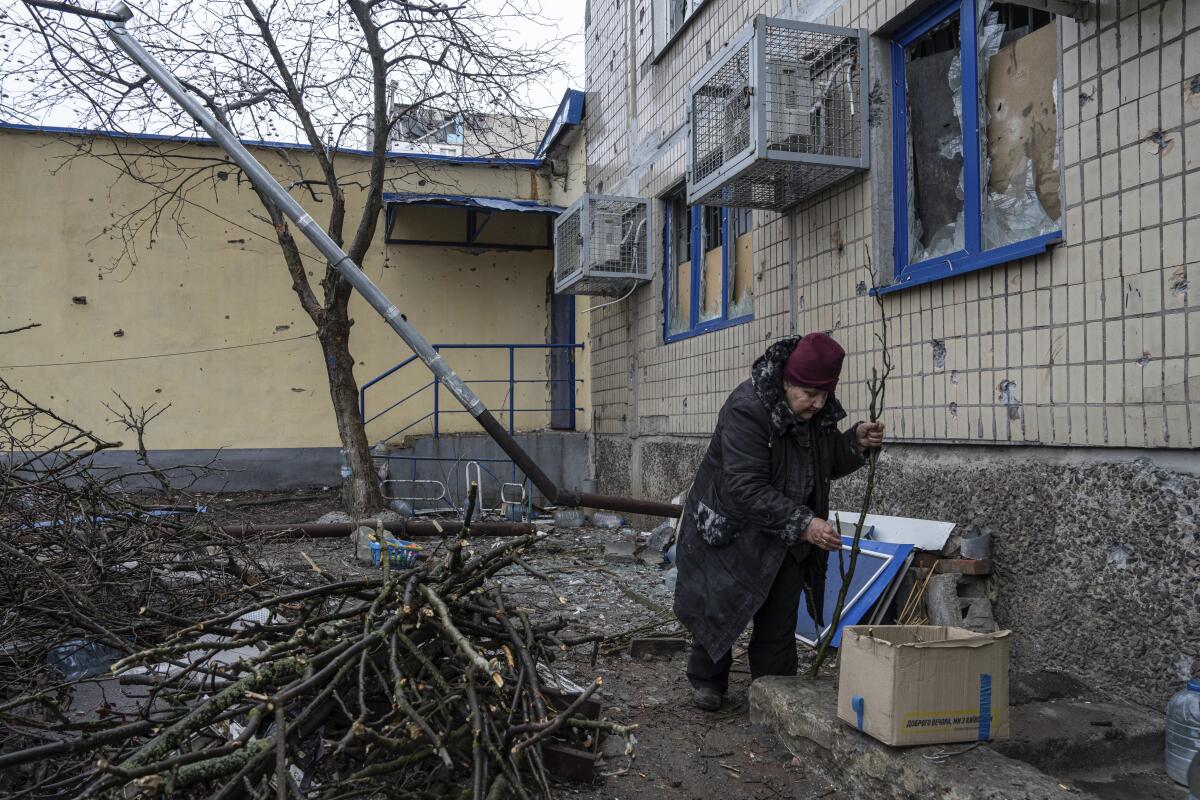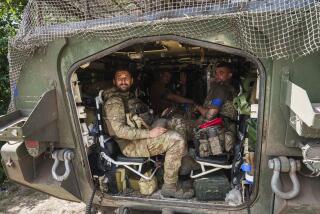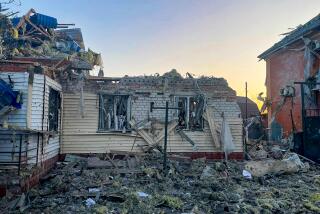On Ukraine front, civilians cling on as troops repel Russia

- Share via
VUHLEDAR, Ukraine — The murky water slowly trickles from the filthy drainpipe into her grimy container — the ticking seconds ramping up the risk that Emilia Budskaya could lose life or limb to Russian artillery strikes torturing her front-line town in eastern Ukraine.
Gaping gashes from shrapnel in the courtyard walls around her testify to the dangers of venturing outside — exposed and without the body armor that Ukrainian soldiers defending Vuhledar wear when they emerge from their bunkers.
But Budskaya and her daughter need water to cling on and survive, to eke out another day in the ruins.
And so they wait — tick, tick, tick — for the container to fill, for Budskaya to then pour the water into plastic bottles and — tick, tick, tick — for her to then start the process again until their bottles are filled.
Picking their way through the debris and mud, they carry their bounty back to the dark basement that now passes for their home.
“We have no water, nothing,” Budskaya says. “I’m getting rain water to wash dishes and hands.”
On the largely static front line between Ukrainian and Russian forces that stretches over hundreds of miles, from the Black Sea in the south to Ukraine’s northeastern border with Russia, Vuhledar has become one of the deadliest hot spots.
It has joined Bakhmut, Marinka and other cities and towns, particularly in fiercely contested eastern Ukraine, as evidence of a grinding and destructive war of attrition, as well as symbols of fierce Ukrainian resistance.
By defending their ruins, Ukrainian forces are slowing costly Russian offensive efforts to extend Moscow’s control over the entirety of eastern Ukraine’s industrial Donbas region. It became Russian President Vladimir Putin’s revised target for conquest after his forces were beaten back from the capital, Kyiv, and northern Ukraine in the invasion’s opening stage a year ago.
Ukrainian soldiers are paying a heavy price, too, but say their sacrifices are wearing down waves of troops and equipment that Moscow is throwing into battle.
In Bakhmut, a soldier who allowed himself to be identified only by his war name, “Expert,” said the pulverized city in the Donbas’ Donetsk region “has become a stronghold” for Ukraine.
“See what they have done to it?” he said of Russian forces that have been pounding Bakhmut for months, slowly inching forward with heavy casualties to capture a prize that, if it falls, might allow Moscow to argue that the invasion is making progress.
“And this is not the only city,” the soldier, who fights in a Ukrainian rapid response unit, added. “I wish they would break their teeth trying to chew it.”
Battlefields around Vuhledar, southwest of Bakhmut and also in the Donetsk region, bear witness to the precious equipment and manpower that Russia is expending, with little territorial gain. Tanks and other armored fighting vehicles blown up by mines or stopped in their tracks by Ukrainian strikes are clumped together on the blasted, cratered terrain.
Although Russia has seized most of the Luhansk region that also forms part of the Donbas, the adjacent Donetsk region remains roughly divided between Ukrainian and Russian control.
On Sunday, Ukrainian President Volodymyr Zelensky marked the anniversary of Russia’s occupation of Ukraine’s Crimea in 2014, expressing confidence the peninsula’s return to Ukrainian control would be part of an end to the war.
“This is our land. Our people. Our history. We will return the Ukrainian flag to every corner of Ukraine,” Zelensky wrote on Telegram.
U.S. State Department spokesperson Ned Price repeated Sunday that “the United States does not and never will recognize Russia’s purported annexation of the peninsula. Crimea is Ukraine.”
Asked whether the United States would support a Ukrainian military effort to retake Crimea, White House national security advisor Jake Sullivan said on CNN’s “State of the Union”: “What ultimately happens with Crimea in the context of this war and a settlement of this war is something for the Ukrainians to determine, with the support of the United States.”
The Ukrainian military said Sunday that Russian forces were building fortifications in Crimea to strengthen their defense, allegedly bringing 150 Russian conscripts from Russia’s Chelyabinsk region, close to the Ural mountains, to perform engineering work.
Saudi Foreign Minister Prince Farhan bin Faisal visited the Ukrainian capital, Kyiv, on Sunday to sign an agreement under which Riyadh will provide humanitarian aid and financing for purchases of oil derivatives. “We hope this helps ease the suffering of the Ukrainian people during this humanitarian crisis,” he said of the agreement that is worth $400 million.
Ukraine’s military said Sunday that Russian assaults in the east remain concentrated on Bakhmut and other objectives.
Russian forces include mercenaries of the notorious Wagner Group, a private military company that has recruited fighters from prisons and tossed them into combat, with high casualty rates. Its millionaire owner with longtime links to Putin, former convicted felon Yevgeny Prigozhin, said Saturday that his fighters had advanced into a settlement on Bakhmut’s northern outskirts. The Ukrainian military disputed that claim, saying Russian forces were repelled.
Donetsk Gov. Pavlo Kyrylenko reported three civilians killed and four wounded in Russian strikes Saturday. Vuhledar and its surroundings were also intensely shelled, he said. Farther along the front line, in the southern Kherson region also split between Ukrainian and Russian control, Gov. Oleksandr Prokudin reported two civilians killed and seven injured in 78 Russian strikes on the region Saturday.
On patrol in Vuhledar’s ruins, hurrying down muddy paths to take cover behind pockmarked walls, Ukrainian soldiers said their fight was larger than for control of the city.
“We fight for our children, for our fellow Ukrainians, for our nation,” said a marine with the war name “Moryak.”
“Because I think what Russia is doing now is genocide of Ukrainians. And Ukrainians don’t have another option but to win.”
More to Read
Sign up for Essential California
The most important California stories and recommendations in your inbox every morning.
You may occasionally receive promotional content from the Los Angeles Times.









